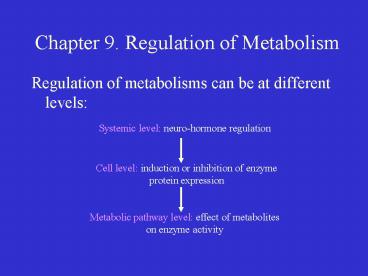Chapter 9. Regulation of Metabolism - PowerPoint PPT Presentation
1 / 20
Title:
Chapter 9. Regulation of Metabolism
Description:
Chapter 9. Regulation of Metabolism Regulation of metabolisms can be at different levels: Systemic level: neuro-hormone regulation Cell level: induction or inhibition ... – PowerPoint PPT presentation
Number of Views:88
Avg rating:3.0/5.0
Title: Chapter 9. Regulation of Metabolism
1
Chapter 9. Regulation of Metabolism
- Regulation of metabolisms can be at different
levels
Systemic level neuro-hormone regulation
Cell level induction or inhibition of
enzyme protein expression
Metabolic pathway level effect of metabolites on
enzyme activity
2
- At the metabolic pathway level effect of
metabolites on enzyme activity - A metabolite may play multiple regulatory roles
not only affects the enzyme activity of the
pathway in which it is produced, but also have
effects on other pathways. - e.g. fatty acyl CoA is an intermediate of lipid
metabolism. It inhibits acetyl CoA carboxylase in
lipogenesis, and also inhibits pyruvate kinase in
glycolysis.
3
Metabolic pathways and their links
4
- Control sites of mainstream metabolic
pathways(1) - Pathway Key enzymes Activators
inhibitors Hormone effects - Glycolysis Phosphofructo- F-2,6-BP
Citrate, ATP Glucagon? - kinase
AMP - Hexokinase
G-6-P - Pyruvate
F-1,6-BP Ala, ATP, Glucagon? - kinase
fatty acylCoA - Gluconeo- Pyruvate Acetyl
CoA F-2,6-BP Glucagon? - genesis carboxylase, ATP
AMP - PEP carboxykinase,
- F-1,6-bisphosphatase,
- G-6-Phosphatase
- Glycogenesis Glycogen highG-6-P
Insulin? - synthase
Glucagon? -
epinephrine?
5
Control sites of mainstream metabolic
pathways(2) Pathway Key enzymes Activators
inhibitors Hormone effects Glycogeno-
Phosphorylase AMP, Ca ATP,G-6-P
Glucagon? lysis
G-1-P Glucose
Insulin ? Pentose-P G-6-P
induced by pathway dehydrogenase
insulin Citric acid isocitrate
AMP,ADP ATP cycle
dehydrogenase Fatty acid Acetyl CoA
Citrate Fatty acylCoA
Glucagon?,insulin? synthesis carboxylase
isocitrate Lipolysis
triacylglycerol
Glucagon?
lipase
epinephrine?
insulin? b-Oxidation Carnitine
acyl Malonyl
CoA transferase-I
6
Control sites of mainstream metabolic
pathways(3) Pathway Key enzymes Activators
inhibitors Hormone effects Cholesterol
HMG-CoA
Cholesterol synthesis reductase
?enzyme synth. Deoxy-
Ribonucleotide ATP
dATP nucleotide reductase synthesis Purine
PRPP amido- PRPP
AMP,GMP nucleotide transferase
IMP synthesis Pyrimidine Carbamoylphosphate
UTP,CTP synthesis
synthase II Urea cycle Carbamoylphosphate
N-Acetyl synthase I
glutamate
7
- 2. At the cell level induction or inhibition of
enzyme protein expression - Enzymes are synthesized in the cytosol. The
factors that stimulate biosynthesis of an enzyme
are called inducers, while those that reduce
synthesis of the enzyme are called repressors. - DNA mRNA Enzyme
protein
repressors
inducers
-
8
- Inducers and repressors may affect transcription
(mRNA synthesis) or translation (protein
synthesis), but they usually regulate the
synthesis of the mRNA for the enzyme protein. - Usually the substrate of an enzyme is an inducer
of the enzyme, especially in microorganisms. - e.g. dietary proteins induce the arginase in
the liver urea production?
9
- The product of an enzyme catalyzed reaction may
be a repressor of the enzyme. - e.g. HMG-CoA reductase in the liver is
repressed by cholesterol. - DNA mRNA
HMG-CoA reductase
Cholesterol
-
10
- Some hormones and drugs may induce biosynthesis
of enzymes. - e.g. some enzymes in amino acid degradation
and gluconeogenesis are induced by corticosteroid
hormones. - Phenobarbital is an anti-insomnia drug which
induces biosynthesis of mixed-function oxygenase,
an enzyme catalyzes degradation of the drug in
the liver.
11
- 3. At the systemic level the neuro-hormone
regulation of metabolisms plays an important role
especially when the homeostasis or external
environments change. - Stress sympathetic nerves?
- glucagon and epinephrine?
TAG - hydrolysis ?, glycogenolysis?,
gluconeogenesis? - blood glucose?.
12
- Starvation glucagon?, insulin?
glycogenolysis?,gluconeogenesis?,
adipose mobilization?, protein degradation?,
glycolysis? maintenance of stable
blood glucose
13
- 4. Mechanisms of hormone regulation Hormone
regulation of metabolisms is mediated by
receptors on the cell membrane or inside the
cell. A signal transduction system is responsible
for flow of the information from the hormone to
the cell. - Characteristics of receptor mediation
- A) highly specificitya hormone only effects
on one or a few metabolic pathways of specific
tissues or cells
14
- B) Hormone regulation can reach a state of
saturationthe receptor can be saturated by the
hormone. - C) Because the signal transduction is a cascade
of reactions, the effect of a hormone on
metabolisms is greatly magnified.
15
- Receptors on the cell membrane they are integral
proteins with a part exposed on the cell membrane
serving as a binding-site for the hormone
molecule.
receptor
epinephrine
ATP
cAMP
PKA
Phosphorylase b kinase
Phosphorylase a
Glycogenolysis
16
- cAMP works as a second messenger for hormone (the
first messenger) regulation - ATP cAMP
5-AMP - Phosphorylase has three forms
Adenylate PPi cyclase
H2O H cAMP phospho diesterase
17
- Effects of some hormones on cAMP conc. and
ultimate functions - Hormone Targets cAMP Effects and
functions - Adrenaline Liver ? Glycogen synthesis
? - Glycogenolysis ?
- Fatty tissue ? Lipolysis ?
- Heart,muscle ? Glycogenolysis ?
- Glucagon Liver,heart ? Glycogenolysis ?
- Fatty tissue ? Lipolysis ?
- b-cell ? insulin secretion ?
- ACTH Adrenal cortex ? Corticosteroid
synthesis? - TSH Fatty tissue,thyroid ? Glycogenolysis?,T3,
T4? - Insulin Fatty tissue ? Lipolysis ?
- liver, muscle ? Glycogenolysis?,Gluconeogen
.? - Glycogen synthesis?
18
- Receptors inside the cells the receptors of
corticosteroid hormones and thyroxine belong to
this class. The hormone can enter the cell to
bind to the receptor forming a hormone-receptor
complex, which in turn causes expression of the
specific gene.
19
hormone
receptor
DNA
mRNA
mRNA
protein
effects
20
- Receptors and diseases abnormal change in the
number or function of a receptor may result in
severe diseases. - e.g. non-insulin dependent diabetes mellitus
(NIDDM) is a result of reduced number or
functional abnormality of the insulin receptor on
the cell membrane the sensitivity of
cells to insulin? blood glucose?
diabetes.































